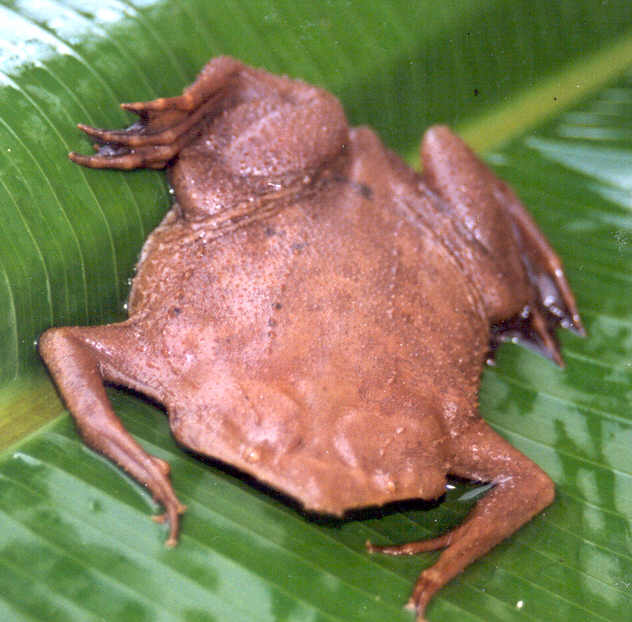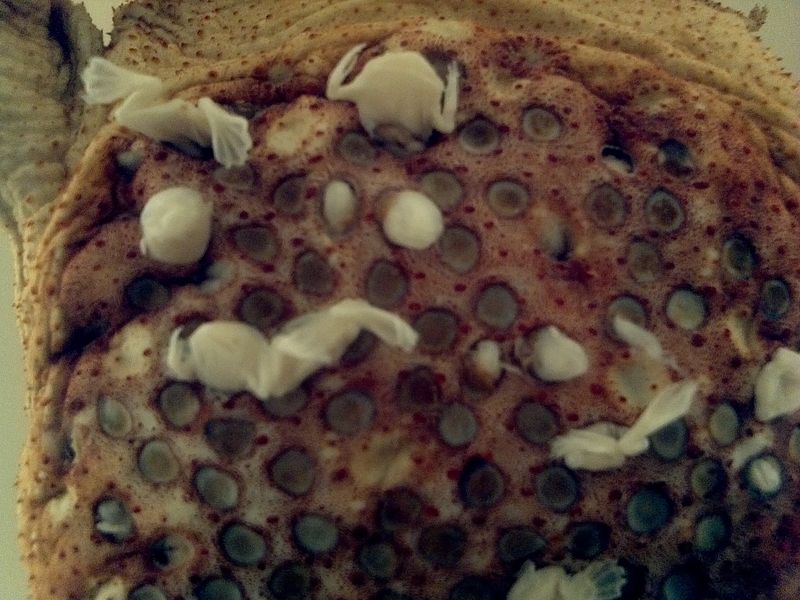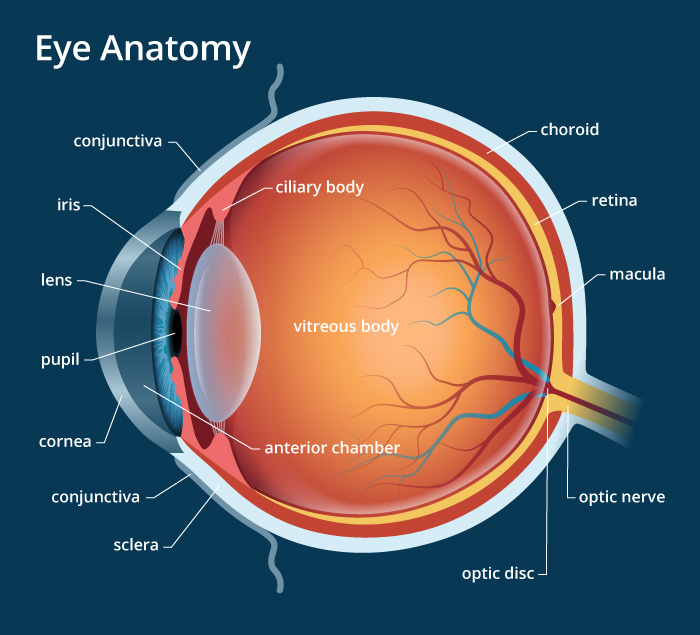Surinam Toad – A Trypophobia Trigger

Surinam Toad
The Surinam toad, scientifically known as Pipa pipa is one of the seven species within the unusual Pipa toad species. With males generally being smaller than female, they have some unusual physical, feeding and reproduction features. Members of this intriguing group have a very flattened body and very muscular limbs, and the Surinam toad is no exception.
With fleshy lobbed fingers on its forelimbs, these toads are really powerful swimmers capable of spotting their prey in a second. These unusual, distinctive amphibians may live up to 10 years and are considered to be a true wonder of nature. Surinam toads live in tropical rainforests and are currently listed as “least concern” by the IUCN. The officials warn the habitat destruction caused by humans could put these toads at risk.
Physical Features and Habitat
The Surinam toad or Star-fingered toad got its name after the country of Suriname but is found in neighboring countries. It lives in the streams, swamps and rivers of South America (especially in the Amazon River), Bolivia, Colombia, Venezuela, Peru, French Guiana, Ecuador, and Brazil. They can also be found at scattered localities in southern and eastern part of Trinidad and Tobago. They live an almost aquatic lifestyle in slow-moving or stagnant waters of tropical rainforests, remaining under water for almost an hour.
The animal has a wide, almost completely flat, rectangular, mud-brown body and a triangular head, which makes them easy to camouflage and hide from predators. The skin is covered with wart-like bumps. This species has been described as having a “star-gazed appearance.”
Some of their most unusual physical characteristics are:
• They have tiny eyes with no eyelids, placed on the upper surface and positioned upwards.
• The maximum length of this species is about 8 inches, with an approximate range of 4 to 6 inches.
• They got the name “Star fingered toad” because of its small, front toes in the shape of a star which assist them in finding food.
- Unlike other members of this group, this toad never stands upright, looking like a leaf or plant debris in the swamp or stream.
Feeding Habits
The Surinam toad hunts primarily at night, keeping its motionless position until the food comes near. They survive by eating insects, crustaceans, worms and small fish. Besides having an unusual body shape, color and posture, they have one more thing that stands out, that being they have no teeth or tongue. Its star-like fingers help them to shovel or suck the prey into their mouth. Being flattened and motionless makes them easy to survive in the wild and hunt its prey.
Reproduction Ritual
Unlike other toad species, the Surinam toad males don’t attract female toads by croaking, since they don’t have vocal cords. Instead of that, male produces a sharp, metallic sound by moving its hyoid bone in the throat. When they find a suitable mate, they adhere to a unique spawning, reproduction ritual by engaging in a special mating dance and swimming together through the water. The female lays its eggs on the male’s belly before the male fertilizes them and attaches to the female’s back. After bypassing the development stage, toadlets are ready to be born.
Surinam Toad Birth – a Trypophobia Trigger
Childbirth isn’t exactly pretty for any species, but when it comes to Surinam toad’s birth, this scene can produce both disgust and fear. Rather than laying their eggs like other species, females keep them really close which is one of the closest and most curious parental bonds in the animal world. After the fertilization process, female toad encloses the eggs with her skin in a honeycomb structure until they are completely developed and ready to emerge. The eggs sink into the skin and the skin grows, forming cysts. Once the baby animals reach a certain size, the skin starts to bubble as they move and they become more and more noticeable. Female toad can carry up to 100 eggs in the small space of her back. After 3 or 4 months, they are ready to emerge, being only 2 cm long, and begin snapping at food. They remain near the surface of the water since they are unable to dive. The mother sheds and grows a new skin layer, preparing it for the next breeding season.

Surinam Toads are a common Trigger
The images of the Surinam toad giving birth can cause the feeling of disgust, and in some cases, fear. People, who experience panic attacks when looking at the cluster of holes, in this case, female toad’s skin with tiny toadlets inside of it, consider this type of Trypophobia trigger extreme.
According to Martin Antony, a psychologist at Ryerson University in Toronto and former president of the Canadian Psychological Association, there are many factors that contribute to fears and phobias because “people can be afraid of absolutely anything. Although the studies on causes of fears have all focused on more common ones, such as spiders and snakes, there is no reason to think that different factors would be responsible for more unusual fears.”The factors that contribute to fears and phobias include traumatic experiences (getting bitten by a dog leading to a fear of dogs, for example), observational learning (watching others be afraid of heights), information and instruction (learning to fear being alone in the dark after watching too many horror movies), and various biological factors (like an inherited predisposition to anxiety). He also explains that fear and disgust while watching certain patterns often go hand in hand, and there is no clear line to be drawn between them. Things that arouse strong reactions like the cluster of holes on natural objects or animal and human skin could be recognized as triggers of fear.
Humans as Visual Beings
While animals like dogs are characterized by the sense of smell, or bats by the hearing sense, humans are undoubtedly visual beings. Vision is one of the most researched areas of neuroscience. Most people don’t know the eye retina is actually an outgrowth of the brain, so at least half of the human brain is devoted to processing visual information. By processing different visual components such as color, size, shape, position, and movement, human brain cooperated with other parts of the body, causing them to react. For example, at least 65% of people are “visual learners.” This estimation came from a research study on engineering students by Dr. Richard Felder in the 1980s, which later became a foundation for a standardized test called the Index of Learning Styles (ILS). People can remember with 90% of accuracy almost 2000 pictures just in few days, which highly exceeds our ability to remember words. Our ability to remember certain patterns which can cause unique reactions, pleasant or unpleasant, allows us to adopt special kinds of behavior towards these patterns. We start recognizing some colors as likable, blue being one of them, while yellow and brown are usually associated with diseases and these are colors to avoid. Some research studies tried to explain the occurrence of Trypophobia triggers and associate them with our visual abilities. “Some people are so intensely bothered by the sight of these objects that they can’t stand to be around them,” explained Stella Lourenco, the Emory University psychologist who conducted one of the studies.

Trypophobia is caused by optical stimulation
The sciences tracked down the papillary response to the Trypophobic images which involved any involuntary movement of the pupils. The researchers recruited 85 students and showed them 60 images of various triggers such as poisonous animals, harmless animals, seed pods, honeycombs, etc. The images of dangerous, poisonous animals produced fear, while others caused the feeling of disgust. Their pupils have dilated, causing the symptoms of panic attacks. This phenomenon probably has an evolutionary basis, due to the fact that humans have an innate aversion towards parasite infestations, infections, skin diseases, irregular patterns on the animal skin. Speckled patterns of dangerous animals could also serve as one of the triggers which Trypophobes recognize as potentially harmful.
High-contrast repetitive patterns are recognized by two types of cells in our eyes, rods, and cones. While cones are responsible for tracking color and tiny details, rods have a different function. The rods are more sensitive to movement and seeing low levels of light. The scientists believe this sensitiveness has one primary purpose, to keep us alive. They can send signals to our brain when a ball is about to hit us, or a car on the road, focusing on individual objects. These findings have enhanced not just the understanding of the human visual system, but they can help explain how this visual perception can contribute to different phobic reactions. The inducing stimuli share the visual characteristic with dangerous organisms or infectious diseases which are stored in our brain. They facilitate a range of rapid, unwilling responses. Getting to know our body and mechanisms that keep us alive can increase our ability to control them and face our fears in a timely manner.
References:
http://www.iucnredlist.org/details/58163/0
http://www.waza.org/en/zoo/choose-a-species/amphibians/frogs-and-toads/pipa-pipa
http://www.bbc.co.uk/nature/life/Suriname_Toad”>http://www.bbc.co.uk/nature/life/Suriname_Toad
http://esciencecommons.blogspot.ba/2018/01/aversion-to-holes-driven-by-disgust-not.html
https://peerj.com/articles/4185/”>https://peerj.com/articles/4185/
http://www.seyens.com/humans-are-visual-creatures/

